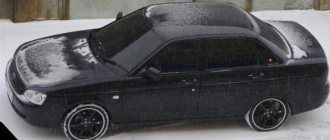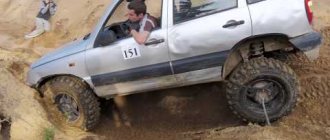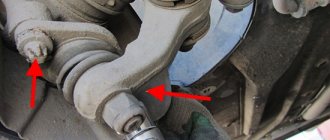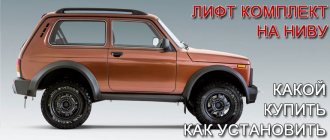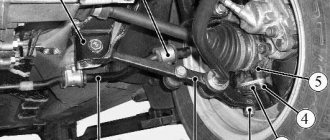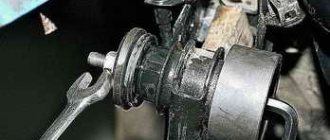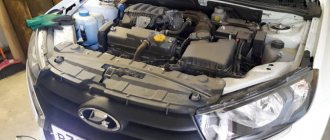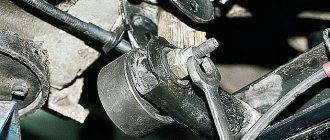Which silent block is better for Niva?
Changing the silent blocks of the front levers on a Chevrolet Niva
When disassembling the front suspension of a VAZ 2121 and its modifications, many car enthusiasts are faced with the question of how to remove the bolt of the Niva lower lever. The fact is that this bolt is the axis on which the lever rests and turns. Therefore, when repairing the chassis, this unit cannot be bypassed; the bolt still has to be removed. Sometimes solving a problem can be quite complex and time-consuming, which is something that motorists who service their Niva themselves would do well to know.
The silent blocks of the front suspension of a VAZ 2121 or Chevrolet Niva are able to withstand any abuse over a period of 80-100 thousand kilometers. If the operation is mainly asphalt, even more. Today we will replace the silent blocks of the upper arm on the Niva (2121, 21214, 21213, 2123) and choose the best one in terms of quality.
To replace the silent blocks of the upper arm we will need:
- 22mm socket wrench.
- Hammer.
- Penetrating lubricant WD-40.
- Puller for silent blocks or hydraulic press.
- A set of new upper arm silent blocks.
Puller for silent blocks
Perhaps, in difficult cases, a gas burner will come in handy. If there is one, you don’t have to think too much about how to press the silent block out of the lever, but simply burn out the rubber and knock out the remains of the silent block from the seats. If you have all this, you can start working.
- We park the car on a level surface, tighten the handbrake and jack up the front end.
- We install a stand under the lower arm, lower the car onto the stand to unload the upper arm. This is a must!
- We remove the wheel and clean the nuts securing the silent blocks from dirt, and also clean and lubricate the nuts securing the upper arm axle with penetrating grease.
- We unscrew the three nuts securing the upper ball joint and at the same time check the condition of its boot. Raise the lever on the axle.
- Without forgetting about the adjusting washers and without losing them, we remove the entire lever assembly.
- Using a 22 wrench, unscrew the nuts securing the silent blocks and thrust washers.
- We tighten all the nuts only after the suspension is loaded, that is, with the car lowered onto a stand under the lower control arm. After replacing the silent blocks, it is advisable to check the camber/toe of the front wheels.
Body repair
Body repair of a VAZ 2121 consists of several types of work.
Restoration of paintwork
Small scratches and dents that appeared during the operation of the VAZ 2121 can be removed with your own hands and not even expensive. For example:
scratches are eliminated by polishing the scratched surface, which is done using various abrasive pastes and materials that remove the top layer of varnish and paint, and this smoothes the scratched surface. In cases where the top layer of soil is not affected, complete removal of the scratch is almost guaranteed.
Restoring body geometry
Due to impacts, temperature changes and metal fatigue, the geometric dimensions of the car may differ slightly from those indicated in the operating instructions, which can create unnecessary stress in various connections and significantly reduce the service life of the car itself. Therefore, checking and restoring the geometry of the car is the main step in the overhaul of its body part.
Basic geometric dimensions of the VAZ 2121 body
If the result is negative, that is, when the actual dimensions differ from the reference ones, the geometry is restored by editing (stretching/compressing) the body and its elements.
Smoothing large irregularities and straightening metal
When individual elements are deformed, the metal is straightened by tapping and extruding it. There are two ways here:
- Without subsequent painting;
- With subsequent painting.
In the first case, the repair is based on the principle of metal elasticity. Since every object that has some kind of elasticity tends to return to its original position, this property can be used for your own purposes - the dent is squeezed out with a special tool and then polished.
Before and after renovation
Unfortunately, this method is only available to people with special tools and extensive experience. I'm afraid that do-it-yourself repairs in this case will smoothly lead us to the second type of repair.
- In the second case, the dent is tapped evenly with a hammer or mallet from the inside, while a “fulcrum” with a soft rubberized surface should be placed on the opposite side.
- If the damage has sharper edges or is a completely deep scratch, then the stand is no longer taken on an elastic basis, but like a rigid stand or even an anvil. Tapping is carried out with a nylon or wooden mallet, from the middle to the edges of the dent.
In cases where straightening the deformation using the above method is impossible, the damaged part is cut out and a patch is applied by welding or using solder or epoxy glue. Otherwise, the element must be replaced.
Getting rid of corrosion and rust
Before starting this stage of work, it is necessary to make sure that the end justifies the means. That is, if the part has already been practically eaten by rye, then, as they say: “It’s too late for Vasya to drink Borjomi when his kidneys have failed.” If everything is not so bad, then we choose one of two methods. Method one. We solder the corrosion areas using solder:
- Preparatory stage. We clean the surface of the body, remove traces of corrosion, treat the edges of the holes with flux;
- Tinning. The surfaces of the “wound” and the patch (if any) are covered with a small layer of solder;
When to change the upper arm silent blocks
The service life of the upper silent blocks of the front suspension on the Niva is quite high. However, signs of wear may appear already after a mileage of 70-80 thousand km, or even earlier if the car is operated on a dirt road. The first sign of a worn silent block is a creaking and knocking sound when driving over uneven surfaces.
In the most advanced cases, a worn silent block will affect the car's handling and ability to keep a straight line; increased uneven tire wear and yaw along the road in a straight line are possible. The easiest way to determine the condition of the silent block is visually - there should be no cracks or chips on the surface of the rubber, and there should be no delamination or play.
"hatchback" viburnum
This full-fledged hatchback with 5 doors acts as a new version in the line of Kalinovsky modifications. The Kalina hatchback first appeared only in 2007, while Kalina has been produced since 1996. It is clear that drastic changes were made regarding the body, but the model also received other engines, more modern and meeting European toxicity standards.
The hatchback is ideal for passing city “traffic light” roads, as it is compact and equipped with an accurate power unit with ESVT. This ensures not only high speed characteristics, but also affects minimal fuel consumption.
The short body length (only 408 cm) helps the hatchback not only successfully maneuver among traffic, but also affects overall safety.
Which silent block is better for Niva?
There are two dozen different silent blocks on sale, ranging from factory VAZ ones to polyurethane ones of various hardnesses. It is not advisable to install polyurethane silent blocks that are too hard - all the vibration will be on the body, and in cold weather a squeak is guaranteed.
- BRT, Balakovo, article 2121-2904040 and 21210-2904040, price about $9;
SEVI, Kedr, BZAK (Belebey) at about the same price and about the same quality, the price per set is about 12 dollars;
The quality and characteristics of polyurethane silent blocks strongly depend on the rigidity of the material, so they must be installed with the expectation that vibrations on the steering wheel and body will be inevitable, and the service life is unpredictable. According to the owners' reviews, the best option for the Niva is VAZ rubber silent blocks, which have proven themselves well over many years of operation.
There are two dozen different silent blocks on sale, ranging from factory VAZ ones to polyurethane ones of various hardnesses. It is not advisable to install polyurethane silent blocks that are too hard - all the vibration will be on the body, and in cold weather a squeak is guaranteed.
VAZ body geometry, fret control points, VAZ body dimensions
This section shows the body dimensions of the VAZ, provides drawings, shows the geometric distances between control points, a table with the geometric dimensions of the openings of LADA/Zhiguli cars, provides data for checking the geometry of door, window and other openings, control dimensions of the VAZ and standards for adjusting the camber/toe.
The most well-known way to determine the quality of the load-bearing part of a car is to measure the distances between control points and compare them with factory parameters. More detailed information about the magnitude of measurements and the location of control points can be obtained by selecting the appropriate model.
Typically the geometry of the following body elements is checked:
1) Diagonals. Before measuring body dimensions using reference points, you can take just two measurements that will help clarify the picture. Drive the car onto an overpass or pit and use a tape measure from below to measure the body diagonally. The diagonals must match.
2) Racks. You definitely need to check the racks. At the beginning - from the unbroken side of the body (if such is known), then - from the bat. In principle, in this case you can choose any body points (the main thing is the same data on both sides). For example, from the pillar to the edge of the bend on the rear doors. Also on the front ones. If the data matches, great. Let's move on;
3) Roof. To make sure that the car’s roof does not “sag”, you need to measure the door diagonals - from the lower rear corner diagonally to the upper front corner. Naturally, the result on both sides should be the same. In addition to this, it is advisable to measure the diagonals of the roof itself;
4) Front and rear glass. For some reason, many people believe that if the windshield “fits” normally, then control measurements are not needed, they say, the geometry of the VAZ body is fine. This is mistake. You need to measure - moreover, diagonally, and choosing points at the same distance on both sides.
5) Visual inspection of a stationary vehicle from all sides
Particular attention should be paid to gaps. On VAZ cars they are quite noticeable
But the main thing is that the gap sizes must be the same on both sides of the machine.
Purpose and design of the product
The main purpose of a silent block or, in simple words, a rubber-metal hinge is to connect suspension parts and dampen oscillatory movements due to the rubber filling inside the product. A truly useful product that has the simplest design. It is a silent block, a metal double bushing with rubber or polyurethane filling inside. This filling plays the main role of damping vibrations and vibrations. The photo below shows silent blocks.
These parts are installed mainly in the front suspension of the Niva Chevrolet vehicle. With their help, the connection between the front suspension arms and the anti-roll bar is ensured. A similar connection is provided in the vehicle's rear suspension, gearbox and engine.
Location of the upper silent block
Rear suspension
The rear suspension is dependent, spring, with hydraulic shock absorbers. The rear wheels of the car are connected to each other by the rear axle beam, as a result of which the movement of one of the wheels in the transverse plane is transferred to the other wheel. The guiding device of the rear suspension (Fig. 38) is longitudinal 3, 17 and transverse 24 rods, the elastic device is coil springs 9, and the damping device is telescopic hydraulic shock absorbers 25.
Rice. 38. Rear suspension:
1 - spacer sleeve; 2 — rubber bushing; 3, 17 — lower and upper longitudinal rods; 4, 11 — spring gaskets; 5 — lower spring support cup; 6 - compression buffer; 7 — finger of the upper longitudinal rod; 8 — bracket for the upper longitudinal rod; 9 - spring; 10 — spring cup; 12 — upper spring support cup; 13 — rod of the brake pressure regulator lever; 14 — shock absorber finger; 15 — body cross member; 16 - additional buffer; 18 — bracket for the lower longitudinal rod; 19 — bracket for the transverse rod; 20 — brake pressure regulator; 20 — regulator lever; 22 — clip; 23 - bushing; 24 — transverse rod; 25 - shock absorber.
Video process of installing silent blocks
Tools:
- Straight box spanner 22 mm
- Puller for removing and installing silent blocks
- Chisel
- Small hammer
Parts and consumables:
- Upper arm silent block (4 pcs.)
Replace silent blocks when they are worn or damaged.
1. Remove the upper arm assembly with silent blocks and axle from the vehicle as described here.
2. Using a 22mm wrench, unscrew the two axle nuts.
3. Remove the thrust washer.
4. To press out the silent blocks, install a puller on the lever so that its cup rests on the end of the lever eye, and screw the puller bolt with an internal thread onto the axle.
5. Tighten the nut of the puller bolt (while holding the bolt from turning).
6. Press the silent block out of the lever.
7. Having removed the silent block from the axle, install it in the eyelets of the lever and use a puller to press out the second silent block.
8. If there is no puller, pry the outer bushing of the silent block with a chisel.
9. Press it out.
10. To install new silent blocks, use a cup puller to press one silent block into the eye of the lever.
11. Before pressing in the second silent block, clamp the lever in a vice, insert the axle with thrust washers into the eyelets of the lever and screw the nut onto the axle from the side of the pressed silent block. We insert the second silent block into the eyelet.
12. Insert a mandrel made from a suitable piece of thick-walled pipe (length 160 mm, internal diameter 42 mm, slot width 32 mm) between the lever eyes.
13. We rest the puller cup against the end of the outer bushing of the silent block.
14. Screw the puller bolt onto the lever axis and press the silent block into place.
Some pullers for removing and installing silent blocks have a half-cylinder that helps tighten the second silent block of the upper arm. The half-cylinder rests on a bolt that is inserted into the axle. Then the pipe section is not needed, skip steps 12,13,14.
15. If there is no puller, we rest the end of the lever eye on the jaws of the vice. We press in the silent block with a tool head of a suitable size (a piece of pipe).
16. Install the lever in the reverse order.
The upper arm axle nuts are finally tightened in the “car on wheels” position. After replacing the silent blocks, check and, if necessary, adjust the wheel alignment angles. Use the services of workshops with special equipment.
The article is missing:
- Photo of the instrument
- Photos of parts and consumables
- High-quality photos of repairs
Rubber-metal hinges of the front suspension have a service life of no more than 80-100 thousand km. Depending on operating conditions, the lifespan before replacing silent blocks on Niva 2121 and Urban is reduced significantly. Diagnosis should be made for the following symptoms:
- Loss of straightness of movement, the car “moving” to the side at a constant speed or braking; Spontaneous changes in wheel alignment angles, uneven tire wear; The presence of booming sounds, rattling when working out irregularities; Body rocking VAZ 21214; The appearance of cracks, scuffs, and tears in rubber and metal structural elements.
Lack of timely attention to the problem leads to damage to adjacent suspension parts, deterioration of controllability and driving safety.
Unscrew the wheel bolts, remove the wheel, having first installed a reliable support.
This is what a spare part looks like, not suitable for further use.
Loosen the bolted connection of the upper ball joint (3 pcs), and then move the part up. Attention, an insufficiently unloaded element can cause injury.
Remove the upper arm assembly using 2 19mm wrenches. If soured, use WD-40.
Place the element in a vice, unscrew the 22 mm nuts from the ends, and remove the thrust washer.
Armed with a puller, press out the silent block.
In the absence of a specialized device, it is permissible to use a chisel. In this case, use a hammer to pry up the edges and remove the hinges.
To install a new part, a puller and a spacer or a tool head are required. When you first set up tools, secure one of the silent blocks in the eyelet.
Secure the lever, insert the complete axle, and secure the installed rubber-metal hinge with a nut. Install the remaining silent block in its place, as well as a 160 mm piece of tube (mandrel) between them.
Place the puller cup against the free end.
Tighten the nuts until the elements are completely installed in their original position.
In the second case, placing the eye on the support, hammer the silent block with a pipe of a suitable size or a tool head.
The second stage using improvised means.
After installing the part on the car, lower the car so as to fully load the structure. Tighten the nuts completely.
In addition to hanging the car, removing the wheel, disconnecting it from the lower ball joint, remove the shock absorber from the lower mounting to the spring cup.
Disconnect the stabilizer clip from the link.
Lower the lever and pull out the spring.
After securing the lever axis with a 19 mm wrench, unscrew the 24 mm nut and remove the washer.
Carefully knock out the axle using a metal rod.
Remove the thrust washers.
Remove the lower arm; do not remove the spring cup.
Using a puller or a heavy hammer, press out the silent block.
Replacing the silent blocks of the front and rear levers with new ones is carried out in a similar manner to the disassembly process. For pressing, use a puller or tool head.
Perform final tightening and adjustment with the machine on its wheels. At the end of the process, do not forget to visit the stand to adjust the wheel alignment parameters.
There are often situations when the silent block, despite efforts, does not give in. In addition to the universal lubricant WD-40 and kerosene, a hacksaw or a torch (blowtorch) will help you change the element. In the first case, try to cut the rubber element without touching the lever, then remove the fragments with a screwdriver or other suitable tools. In the second, heat the polymer until it burns out, then knock out the clip with a sledgehammer and a screwdriver.
The service life of the upper silent blocks of the front suspension on the Niva is quite high. However, signs of wear may appear already after a mileage of 70-80 thousand km, or even earlier if the car is operated on a dirt road. The first sign of a worn silent block is a creaking and knocking sound when driving over uneven surfaces.
In the most advanced cases, a worn silent block will affect the car's handling and ability to keep a straight line; increased uneven tire wear and yaw along the road in a straight line are possible. The easiest way to determine the condition of the silent block is visually - there should be no cracks or chips on the surface of the rubber, and there should be no delamination or play.
Checking the clearance in wheel bearings.
If there is wear in this unit, then when driving or picking up a certain speed, strong vibration may be observed on the steering wheel. Over time, this can lead to more serious problems, such as uneven tire wear. This is due to the fact that there may be no clearance necessary for the hub to rotate. In normal condition it should be at least 0.15 mm. To adjust, you will need a wheel wrench, a 27 wrench and a hammer.
To check, you need to remove the wheel, then rock it in a vertical plane. For a more accurate check, you need to ask an assistant to press the brake pedal and rock the wheel again. If the knocking noise disappears, this confirms that there is a problem with the wheel bearing.
To eliminate the play, it is necessary to remove the cap and loosen the hub nut. To do this, it is better to use a suitable wrench. In this case, it is better to immediately replace the nuts with new ones, because the old one may return to its position and it will not be possible to properly lock it, since its sides may be damaged.
For tightening, it is better to use a torque wrench so that the force does not exceed 19.6 N*m or 2 kgcm.
Also, the appearance of a knock in the front suspension may be due to incorrect adjustment of the wheel alignment angles. To do this, you need to contact a specialized service to check these parameters on a stand. An incorrect angle leads to increased tire wear and fuel consumption. Over time, this causes suspension elements and wheel bearings to fail. The car loses control.
If knocking occurs in the front suspension, you need to pay attention to the exhaust system. Frequently occurring noise in the front of the car can occur when the muffler or resonator mount is misaligned.
This manifests itself in a knocking sound when changing the throttle. It is better to check on a cold engine. To do this, you can grab the end of the exhaust pipe and swing it in different directions. In normal condition, the exhaust system should not produce any knocking noises. The appearance of noise will indicate damage to the fasteners. In this case, it is necessary to install the car on an inspection hole and check the exhaust system components more carefully.
Why is the node disassembled?
There are several objective reasons why it is necessary to disassemble the entire front suspension and remove the lower arms. They are associated with the following circumstances:
- most often the unit is disassembled to replace the rubber-metal articulated bushings - silent blocks;
- the lower arm needs to be replaced due to its damage or breakage;
- It is necessary to remove the front beam to replace it or carry out other repair work.
The problem is that on about 50% of Niva cars, the bolt, which is the axis of the lower arm, does not want to voluntarily leave the front beam bushing. In other words, the axle becomes so sour that it is not only impossible to pull it out, but even to turn it. Moreover, on Nivas produced back in the Soviet era, this problem does not exist.
This raises another reason why it is very advisable to disassemble the lower part of the suspension in the first year of operation of the machine - prevention.
Before the axis of the lower arm has time to firmly stick to the bushing, it must be removed, cleaned and lubricated with graphite lubricant. This will save you from many problems in the future, since dismantling a stuck bolt will take a huge amount of time at the most inopportune moment.
Is it worth doing the repairs yourself?
Any repair requires not only experience, plumbing skills and a standard set of tools. Most operations are performed on an inspection pit or overpass.
Repairing a car yourself is worth it only if you have the necessary equipment and tools. It is often cheaper to go to a service station than to buy pullers or keys for a one-time job.
And also interesting: Tuning Niva 2121 with your own hands: body, interior, suspension "
Suspension repair is a serious process on which your safety on the road depends. If you are not confident in your abilities or do not have the necessary tools, it is better to turn to professionals.
Pre-disassembly procedure
To get to the axle, remove it and change the silent blocks, you need to prepare the tools:
- jack with wheel wrench;
- open-end and ring wrenches of standard sizes;
- set of heads and knobs;
- To dismantle rubber-metal hinges, it is advisable to have a puller;
- powerful hammer;
- mount;
- other locksmith tools.
It is not necessary to carry out work on removing the lower arm axis from an inspection hole or on a lift; an open, flat area is sufficient. But some operations are more convenient to perform from a ditch, so its presence is desirable. It is better to wear cloth gloves on your hands so as not to bruise your fingers. Having secured the car in place using wheel chocks under the rear wheels, you can begin disassembly, which is carried out in the following sequence:
- Raise the car on a jack, unscrew and remove the front wheel. Place a block under the lower lever and lower the car onto it.
- Unscrew the 3 lower ball joint fasteners and separate the hub assembly from the arm.
- Unscrew the 2 nuts of the bracket that holds the end of the anti-roll bar to the side of the arm. Use a spatula to remove it from the studs.
- Disconnect the shock absorber from the spring support pad by unscrewing its lower mount. Raise the car with a jack and remove the spring. There is no need to remove the support pad from the lever, unless it is in the way.
- While holding the head of the long bolt that holds the lower arm, unscrew the nut on the other side and remove it along with the washer.
- Using a hammer and a round brass socket, carefully knock the axle out of the bushing. There are several adjusting washers inserted between it and the lever; when knocked out, they will fall out. You can't lose pucks.
The adjusting washers located between the lever and the front beam bushing are installed on the Niva 2121 at the factory. During assembly, they must be returned to their place in the same quantity. Once disassembly is complete, you can begin replacing the silent blocks using a puller. If this is not available, the old rubber-metal bushings are knocked out in a vice, and new ones are carefully pressed into their place using an extension from a piece of pipe.
When assembling the unit, it is very important to treat the entire surface of the lower arm axis with graphite lubricant.
This will save you from suffering and wasting a lot of time during the next disassembly if the bolt becomes tightly stuck.
Getting rid of scratches
Minor rust and blistered paint that appears on a car is not a reason to completely replace the body. In this case, the operation to restore the Niva can be easily carried out independently, while saving a decent amount of your own funds.
For example, scratches can be removed by polishing the paintwork. To carry out this operation, various grinding compounds and special materials are usually used. With their help, you can easily and quickly remove the top layer of paint, thereby smoothing out shabby areas on the body. Complete elimination of scratches is only possible if the outer layer of paintwork is not severely damaged. It is also not recommended to remove too much paint when restoring the Niva -2121 with your own hands.
What to do when a part is stuck?
The first signs of trouble can be detected early. To do this, unscrew the axle mounting nut with a 24 mm wrench, and then use a socket with a wrench to try to turn the bolt. If this cannot be done even with the elongated lever of the crank, then get ready for a lot of work - the axle is clearly stuck. In some, especially advanced cases, a stuck bolt does not even allow the spring to be released and pulled out.
There are several ways to solve the problem, but none of them are easy and will require from 1 to 5 hours depending on the degree of souring of the axle. Experienced owners of Niva 2121 practice the following method of dismantling the part:
- Using an angle grinder, cut off the axle on both sides to free the lower arm and remove it.
- Use a gas torch or blowtorch to heat up the part of the front beam with the bushing.
- Try to move the axle with strong blows of a hammer. If this was possible, but the end of the cut bolt was flattened, then you need to trim it again and knock out the part completely.
- If the bolt does not move, it is necessary to repeat the heating and cooling cycles several times. You can weld a crowbar to the cut-off part of the axle, with which you can try to turn it while warming up.
The described procedure usually takes 1-2 hours. If after this time you have not been able to move or rotate the steel rod, you need to move on to drastic methods:
- drilling a bolt from the sleeve with a hand drill;
- complete disassembly of the chassis and removal of the front beam.
The dismantled beam must be taken to the nearest car service center, where the rod will be pressed out with a press or drilled out on a machine.
If you find an error, please highlight a piece of text and press Ctrl Enter.
Read news about the new Niva
- The modernized Lada Niva Legend (4x4) 2021 was shown on the Internet
- Lada 4×4 Bronto - sales stopped, new details » Lada.Online - all the most interesting and useful about LADA cars
- Description of the instrument panel Lada 4×4 (VAZ 2121, 2131) » Lada.Online - all the most interesting and useful about LADA cars
- Chevrolet Niva gasoline consumption per 100 km
- Buy LADA (VAZ) 2131 (4×4) 2022 in Rostov-on-Don, low price for Lada 2131 (4×4) 2022 on the Avto.ru website
- Fuses Niva 21214 injector «
- The new large Lada 4×4 Niva “Bigster” 2021-2022 based on the Dacia Bigster was shown for the first time. The SUV has changed beyond recognition
- New Niva Chevrolet Lux 2022 - review of GLC equipment
Technical characteristics (3-door, 5-door and Urban)
BRIEF CHARACTERISTICS FOR LADA 4X4 (3 doors) 1.7 L 8 KL. (83 HP), 5MT (2017)
BRIEF CHARACTERISTICS FOR LADA 4X4 (5 doors)
BRIEF SPECIFICATIONS FOR LADA 4X4 Urban (3 doors)
DETAILED TECHNICAL CHARACTERISTICS OF VAZ-21213 and 21214 CARS
VAZ-21213 and its modifications are all-terrain passenger cars. All wheels are constantly driven (non-disconnectable all-wheel drive), there is a center differential locking mode. The body is load-bearing, all-metal, welded. Engine – four-cylinder, in-line, petrol, four-stroke; location – anterior, longitudinal. The VAZ-21213 is equipped with a carburetor engine mod. 21213 with a displacement of 1.7 liters, on the VAZ-21214 - engine 21214 of the same volume with distributed fuel injection. (Previously, VAZ-21214 cars were equipped with a 21214 engine with central fuel injection and a microprocessor ignition system). VAZ-21215 (supplied for export) is equipped with a diesel engine XUD-9SD with a displacement of 1.9 liters from the Peugeot-Citroen concern.
How to diagnose a problem
If it is necessary to more accurately check the shock absorbers, this procedure can be performed on a vibration stand. Such equipment allows you to simulate real road conditions while simultaneously reading information using special sensors.
If it is not possible to perform diagnostics of this type, then you can determine the performance of this part by rocking the car body, as described above, or by removing the shock absorber and bleeding it. If the rod moves freely, the shock absorber will have to be replaced.
Preparation for repair
It is quite possible to carry out repairs to the bottom of any Niva model yourself. Before welding a complete bottom or installing patches, dismantle the interior.
- Remove the seats.
- Remove the carpet.
- Remove the old sound insulation.
- Move the electrical wiring to the side to avoid touching the wires during repairs.
Tools you will need:
- hammer;
- welding machine;
- screwdrivers;
- electric drill;
- Bulgarian.
After removing the sound insulation, the metal is thoroughly cleaned and wiped dry. Problem areas are cleaned with a grinder. It can be replaced with fine-grained sandpaper. Then the metal surface is degreased and treated with an anti-corrosion agent.
Welding work
The first step is to remove rusty metal and corrosion. It is advisable to carry out this work with a grinder. Hard-to-reach places are cleaned using a gas welding machine. Then the metal patches are cut out. This is done with special scissors. This way you can make correct, even workpieces without torn edges.
It will be easier for two people to weld a new floor, since you will have to fix the patch and weld it at the same time. Basic rules for welding the bottom:
- The patch is stuck at 3-4 points, and then completely scalded.
- Short sutures are used to correct small defects. Length – 3 cm.
- The patch is applied as tightly as possible. In gaps, corrosion quickly forms again.
- To increase the strength of the seams, they are hammered.
After repairs, be sure to check the work done in a well-lit room. If necessary, weld the seams on the Niva again. Only after this can the seam beads be cleaned.

